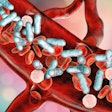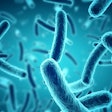
Researchers have developed a new aquaculture-based method to harvest immune cells from horseshoe crabs that preserves the crustaceans while also creating the potential for new clinical applications, like testing blood for sepsis, according to a study published in Frontiers in Marine Science on April 1.
Each year, over 600,000 Atlantic horseshoe crabs (Limulus polyphemus) are harvested in the wild in the U.S. for bleeding to extract amebocytes used in the production of Limulus amebocyte lysate (LAL), an aqueous extract of blood cells. The extract reacts with bacterial endotoxin lipopolysaccharide (LPS), a membrane component of gram-negative bacteria.
This interaction is the basis for the LAL assay, a standard test for the detection and quantification of gram-negative bacteria. The LAL assay can detect up to 80% of pathogens that lead to sepsis, a condition that results in around 11 million deaths per year. The assay is commonly used to detect bacterial contamination on the surface of scientific and medical equipment.
But use of the LAL assay in humans has been limited, due in part to reactivity issues between human blood and LAL from crabs harvested in the wild. Also, about 30% of crabs die during the bleeding process, a mortality rate that puts pressure on wild populations that are already classified as vulnerable.
In the study, lead author Rachel Tinker-Kulberg, PhD, and colleagues discussed how they could deal with both issues. They described a process for extracting amebocytes from horseshoe crabs kept long-term in a recirculating aquaculture system using an indwelling catheter up to 24 times per year. The method essentially obviates the need to harvest crabs from the ocean.
The health of the horseshoe crabs was measured with metrics such as stable hemocyanin levels, amebocyte density, and aquaculture LAL activity. The aquaculture system also produced healthier horseshoe crabs, as measured by higher reactivity of LAL relative to commercial LAL kits.
If the system were scaled up to industrial dimensions, a single cohort of 45,000 horseshoe crabs in an aquaculture system would produce enough LAL to fulfill current needs, including clinical applications, according to the study authors.
The results of the study also revealed the potential of aquaculture-derived LAL as a rapid, reliable, and cost-effective method for detection of LPS as a marker from gram-negative bacteria in human blood. A new blood assay developed by the researchers relies on the separation of blood components via chemical treatment to isolate LPS in blood with a gel clot test. Without interference of inhibitors, LAL is sufficiently sensitive to toxins across a clinically relevant range of 1 to 500,000 colony-forming units per milliliter of blood.
"LAL has never before been used for patient diagnostics due to cross-reactivity and inhibitors in human blood," said Anthony Dellinger, PhD, study co-author and president of Kepley BioSystems, in a statement. "Using high-quality and potent LAL from aquaculture, we have now developed a method that makes blood samples compatible with the LAL assay, allowing it for the first time to be used in early, potentially life-saving detection of bacteria and fungi in blood."



















